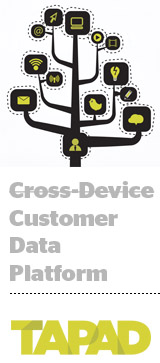
Tapad launched a product on Tuesday that lets telcos stitch their first-party data to Tapad’s device graph – which Tapad will then activate through partners, including Facebook and The Trade Desk.
The company is calling this service a Customer Data Platform (CDP), which is the buzzword du jour, though the vendor said it’s been working on the project since early 2016, when Norwegian telco Telenor acquired the company. Tapad claims this project was a big deal driver.
Of course, it remains to be seen whether other telcos are willing to onboard their precious first-party assets to Telenor.
The move correlates with Tapad’s divestiture of its managed media business, which social marketing tech firm Brand Networks took over as part of a structured deal in late January.
When it comes to the CDP, Tapad’s role is as data processor and tech provider.
Marketers are looking to do more than just tie devices together under a single ID, said Tapad CEO Sigvart Voss Eriksen. They’re looking to activate their first-party data and manage identity across platforms.
“Devices are one parameter for doing that, but it’s also about interests and context,” he said.
A few months after its Tapad acquisition, Telenor experimented with combining purchase intent data and online behavioral data to create targeting segments for one of its mobile network operators, or MNOs. The goal was to drive digital sales and lower customer acquisition costs through personalization.
Early results were promising – one MNO in Southeast Asia reduced its cost per acquisition by 75% – and Telenor started applying the method to its operators in other markets across its footprint.
Tapad’s CDP is a productized version of this internal solution, and the company is now busy pitching it to other telcos in APAC, EMEA and the US.
Voss Eriksen said Telenor is in advanced talks with several large telcos to use the Tapad CDP.
“Telcos are very protective of their first-party data and there’s a big fear of data leakage,” he said. “And to be honest, there was concern when we started out on this journey whether other telcos, even ones we don’t compete with, would use this solution. But it’s actually a tremendous advantage for us having a large telco as an owner.”
Telenor knows firsthand the pressure telcos are under: Its business is global and it has several MNOs in Europe, where the regulatory environment is set to get even more strict with GDPR and the ePrivacy regs coming down the pike.
And despite battening down the hatches in anticipation of more rigorous regulation, telcos are still interested in capitalizing on the richness of their first-party subscriber data, as long as they can do it in a privacy-safe way.
But they’re also looking for visibility beyond their own data sets, Voss Eriksen said. The CDP allows them to use their own subscriber data as a truth set against Tapad’s identity graph.
“Telcos typically have very good data scientists and an extremely granular view into their own customers, but they’re virtually blind for any usage that happens outside their own network,” Voss Eriksen said. “That is where we come in, to help make them relevant to consumers they may only have a partial view of or no view at all.”
Other players in the telco space are also looking for a piece of the action as operators figure out how to turn their data into ad dollars.
On Wednesday, Emodo, the mobile advertising division of Ericsson, announced the acquisition of location-focused DMP/DSP Placecast to bolster the Swedish telecom giant’s ongoing investment in ad tech.
This post was syndicated from Ad Exchanger.

More Stories
Deep Blue Is Building a Women’s Sports Yacht Club at Cannes
Sinclair SVP of Station Operations to Retire in June
Netflix Sets Up Killer You Marketing Activation With Penn Badgley